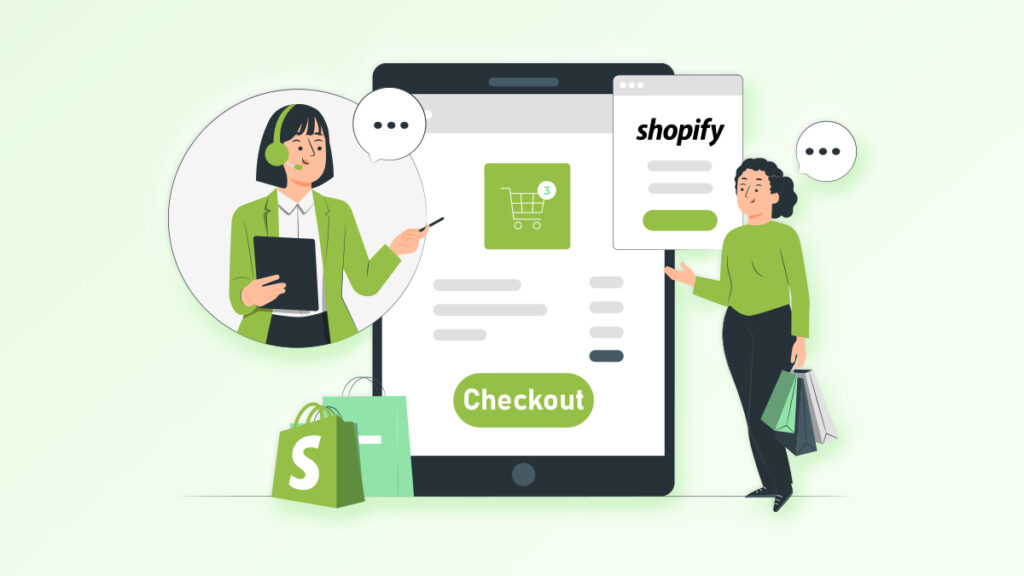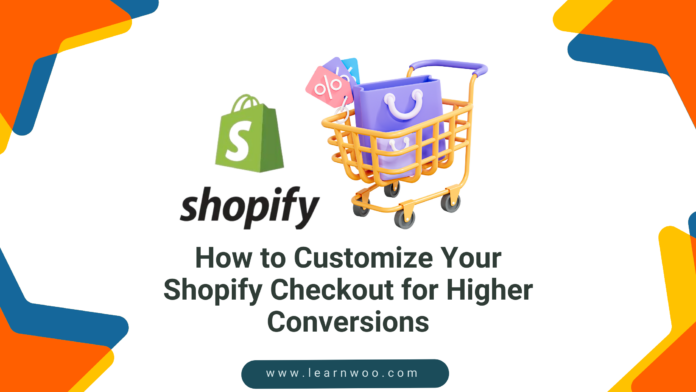Understanding Shopify Checkout Customization


Within the e-commerce business, it is said that one either wins or loses a sale with the checkout experience.
Ahead of online retail trends, Shopify understands this and avails to the users possibilities for fine-tuning the process of checkout customization.
These customizations are not mere cosmetic tweaks but rather they are strategic tools to smooth out the purchasing journey and thus, exercise a very strong influence upon the ultimate decision of the customer.
Optimizing the checkout flow is critical. Even the slightest streamlining of the checkout process may result in improved Average Order Value (AOV), reinforced customer satisfaction, and most importantly, lowered cart abandonment.
Every click matters in the digital retail world. Reducing the steps to purchase, clear information and a smooth transaction experience are pertinent to keep the browsers becoming buyers.
Using Shopify’s customization capability, it can make businesses customize according to the brand and user requirements of the business.
This alignment is more than just aesthetics, it is about an organized and soothing journey that glides the customer effortlessly from cart to confirmation.
Businesses can witness a notable increase in sales performance as well as an amplification of customer loyalty by mitigating this crucial touchpoint.
Shopify vs. Shopify Plus Checkout Customization
Shopify’s checkout process is lauded for its simplicity and efficiency.
Key features like the one-click checkout and Shop Pay streamline the buying process.
However, the extent of customization varies between Shopify’s regular and enterprise-level offering, Shopify Plus.
For standard Shopify users, the customization options are limited but impactful.
Shopify merchants can edit order summaries, adjust colors and fonts to match branding, and add custom fields or notes.
These straightforward changes maintain brand consistency and improve user experience.
Shopify Plus enables deeper, more advanced customization. It caters to high-volume enterprises needing more control and flexibility.
Businesses on Shopify Plus can access and modify the checkout. liquid code for fuller customization.
Shopify Plus opens possibilities like customizing layouts, integrating scripts for analytics or A/B testing, and offering diverse payment options.
It also supports exclusive integrations and advanced security, ensuring a safe, scalable checkout.
The choice between Shopify and Shopify Plus depends on business needs and resources.
Shopify provides sufficient customization for most small and mid-sized businesses.
But Shopify Plus is better suited for large companies requiring high-level customization control.
Ultimately, while Shopify checkout meets the needs of most merchants, Shopify Plus provides greater flexibility for enterprises with advanced requirements.
The key is assessing business size, revenue, and specific customization needs.
To fully exploit the advanced features of Shopify Plus, hire Shopify developers who can unlock the full potential of your e-commerce platform.
Top Shopify Checkout Customizations
One-Page Checkout
The one-page checkout trend minimizes steps to reduce abandonment. Best practices include:
- Streamlining forms into a single scrolling page
- Using clear section headings to orient customers
- Offering express “guest” checkout for non-account holders
- Integrating autofill and autocomplete to speed up form completion
- Making the “Place Order” call-to-action button obvious throughout
- Displaying order summary details for confirmation before final submission
Checkout Cross-Sell
Effective checkout cross-sells should:
- Be relevant to the main items in the cart to provide a logical upsell
- Appear after the customer has entered payment info when a purchase is committed
- Limit to 1-2 complementary products to avoid choice overload
- Use compelling messaging around bundling for higher-value
- Offer discounts or free shipping to incentivize adding cross-sells
- Allow easy one-click adding to the cart without leaving the checkout flow
Express Checkout
Best practices for express checkout include:
- Offering multiple express options: Apple Pay, Google Pay, Amazon Pay, etc.
- Displaying express checkout buttons prominently above the main form
- Allowing express checkout for guest customers without accounts
- Integrating express options across devices: mobile, desktop, etc.
- Ensuring seamless transition from express checkout to standard checkout in case of failure
- Promoting express checkout benefits like speed and convenience
Trust Badges
For effective trust badges, focus on:
- Select reputable badges like Norton, TRUSTe, and BBB to build credibility
- Adding visual markers for security like padlock icons
- Drawing attention to site encryption and data safety
- Placing trust elements near sensitive areas like payment forms
- Ensuring badge icons are clear and clicking reveals more info
- Avoiding excessive badges that raise skepticism
Account Creation Prompt
Best practices for encouraging account creation include:
- Offering benefits like saved payment methods and shipping info
- Allowing password-free checkout now with the option to create an account later
- Keeping copy brief – “Create an account for faster checkout”
- Auto-filling form fields if the customer intends to create an account
- Offering a discount incentive for new account signups
- Sending follow-up email reminders to complete account creation
- Streamlining the creation process via social media login integration
- Using a two-step checkout with account creation after order placement
Cart Reminder Emails
Effective cart abandonment reminder emails:
- Trigger automatically for those who’ve left items sitting in the cart
- Send within a day while the intent is still fresh
- Lead with a compelling, personalized subject line
- Showcase previously added products visually
- Provide a clear call-to-action button to return and checkout
- Offer a discount code or gift as a purchase incentive
- Use urgency messaging if cart items are at risk of selling out
- Remain retailer-branded for familiarity and trust
Checkout Progress Tracker
For optimized progress trackers:
- Display step numbers and progress bar persistently visible
- Keep steps minimal – ideally 3 or less
- Use compelling headlines for each step
- Allow customers to easily navigate back and forth
- Auto-update tracker as the customer moves through the flow
- Indicate required unfinished steps if the customer jumps ahead
- Provide continued visibility through order confirmation
- Test different tracker placements to find an optimal spot
Advanced Checkout Customization Strategies
Subscription Nudges
E-commerce brands like Tabs Chocolate use the checkout process to upsell customers into subscription programs. Some effective strategies include:
- Offering discounts for first-time subscribers, such as 20% off for 3 months
- Allowing customers to “Try Before You Commit” with a trial period before being billed
- Highlighting the convenience and savings of automated deliveries
- Providing easy self-service management for modifying/canceling subscriptions
- Using progress bars to show how close they are to free shipping thresholds
- Leveraging smart timing, such as when a customer is checking out with a single purchase, prompts them to switch to a subscription for savings on future orders.
The key is presenting the value in clear and compelling ways while streamlining the upgrade process within existing checkout flows. This establishes recurring revenue streams.
Loyalty Programs
Integrating loyalty programs into checkout keeps customers engaged with the brand. Examples of The Sewing Studio include:
- Displaying current loyalty points balance and tier status
- Detailing what rewards points can be redeemed for
- Offering special discounts or bonuses for point redemptions to incentivize use
- Allowing partial points + payment combinations for redemptions
- Promoting referral programs to earn more points
- Showing progress trackers toward unlocking next-tier
- Providing easy self-service account management
Loyalty program integration persuades customers to stay invested in the brand to earn ongoing rewards. The key is making redemption and tracking seamless from checkout.
Social Proof
Showcasing social proof like customer reviews and testimonials at checkout boosts conversion. Examples like The Lost Co:
- Curate recent positive reviews of the specific product being purchased
- Pull from verified buyer reviews for authenticity
- Feature visuals like photos from customers for relatability
- Use brief but compelling quotes that ensure product quality
- Have easily accessible links to read full reviews
- Show review scores prominently like star ratings
- Balance reviews from both text and video testimonials
The right mix of social proof elements endorses products from real customers, overcoming hesitations at checkout. Keep the design clean to avoid overwhelming shoppers.
Handling Shipment Delays
Brands like Gymshark use the checkout experience to set proper expectations around shipment delays:
- Displaying anticipating processing and delivery timelines transparently
- Calling out any known issues affecting logistics like COVID-19, weather events, etc.
- Providing order status lookup options for tracking after purchase
- Sending email updates on order fulfillment and shipping status
- Offering access to customer service for assistance with delayed orders
- Allowing easy order cancellation and refund if customers don’t want to wait
- Compensating for delays with discounts on future purchases
Proactively managing shipment delays protects the customer experience. The focus should be on transparency, providing status visibility, and adding value if delays occur.
Free Shipping Thresholds
Checkout is a strategic point to encourage free shipping minimums. Tactics Pura Vida uses include:
- Displaying how much more is needed to get free shipping
- Incentivizing additional purchases with discount codes & promotions
- Recommending compatible products to help reach a threshold
- Offering reduced shipping costs just below the free threshold
- Allowing the option to update the cart and re-calculate shipping costs
- Showing dollar value progress bar approaching free shipping
- Upselling to premium delivery options with lower minimums
- Reminding of threshold when a customer attempts to pay below it
With creative messaging and incentives, free shipping thresholds prompt higher order values and conversion rates.
Conclusion and Best Practices
In conclusion, customizing the Shopify checkout experience is a dynamic and effective way to enhance e-commerce performance.
From the basic aesthetic changes available in standard Shopify to the advanced customization capabilities of Shopify Plus, there’s a range of options to suit different business needs.
Key takeaways include the importance of a streamlined checkout process, the effectiveness of cross-selling and upselling, and the value of building trust and convenience for the customer.
Businesses should focus on creating a seamless, intuitive checkout experience that aligns with their brand and customer expectations.
Best practices for effective checkout customization include:
- Keeping the design clean and user-friendly.
- Displaying security badges and trust signals.
- Offering multiple payment options to cater to a diverse customer base.
- Using data and analytics to understand customer behavior and make informed adjustments.
- Continuously testing and optimizing the checkout experience for performance improvements.
By following these strategies, businesses can significantly improve their online shopping experience, ultimately leading to increased conversion rates, customer satisfaction, and loyalty.
FAQs on Shopify Checkout Customization
Can I customize the checkout process on my Shopify store?
Yes, Shopify allows customization of the checkout process, though the extent of customization depends on whether you’re using standard Shopify or Shopify Plus.
What are some effective ways to reduce cart abandonment during checkout?
Simplifying the checkout process, offering multiple payment options, and ensuring mobile optimization are effective strategies to reduce cart abandonment.
How can I add trust badges to my Shopify checkout?
Trust badges can be added through Shopify’s theme settings or by using apps from the Shopify App Store.
Is it possible to offer subscription options at Shopify checkout?
Yes, subscription options can be offered through Shopify’s native features or third-party apps designed for subscription management.











